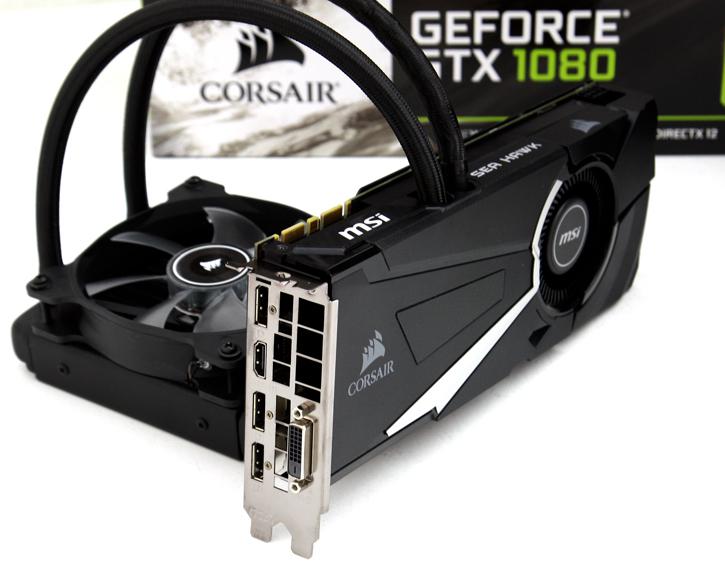Introduction
MSI GeForce GTX 1080 SEA HAWK X
Running the 1080 fly like a G6
In this review we'll fire up some GeForce GTX 1080 testing from MSI with a Hydro cooler from Corsair, yes join us as we test the symbiosis called MSI GeForce GTX 1080 SEA HAWK X . This is the gear that everybody in the enthusiast crowd is waiting to see; board partner cards, all custom, tweaked and cooled better and the SEA HAWK X certainly fits that description with its AIO liquid cooler mounted on top of that Pascal GPU. The GPU industry has been on hold, waiting for a smaller GPU fabrication process to become viable. Last generation GPUs were based on a 28 nm fabrication, an intermediate move to 20 nm was supposed to be the answer for today’s GPUs, but it was a problematic technology. Aside from some smaller ASICs the 20 nm node has been a fail. Therefore the industry had to wait until an ever newer and smaller fabrication process was available in order to shrink the die which allows for less voltage usage in the chips, less transistor gate leakage and, obviously, more transistors in a GPU. The answer was to be found in the recent 14/15/16 nm fabrication processors and processes with the now all too familiar FinFET + VLSI technology (basically wings on a transistor). Intel has been using it for a while, and now both Nvidia and AMD are moving towards such nodes as well. Nvidia is the first to announce their new products based on a TSMC 16 nm process fab by introducing Pascal GPU architecture, named after the mathematician much like Kepler, Maxwell and Fermi. That stage has now passed, the GeForce GTX 1070 and 1080 have been announced with the 1070 and 1080 cards slowly becoming available in stores as we speak. Both models are equally impressive in its product positioning, though I do feel the 1070 will be the more attractive product due to its price level, the 1080 cards really is what everybody want (but perhaps can't afford). The good news though is that the board partner cards will offer SKUs for less opposed to the Nvidia reference / Founder edition cards. Obviously the higher-end all customized SKUs will likely level with that founders edition card price level again, but I am pretty certain you'd rather spend your money on a fully customized AIB card that is already factory tweaked a bit opposed the the reference one.
So merely a few weeks after launch, I think this is our 6th Geforce GTX 1080 review already ? This time we revert back to team at MSI who partnered up with Corsair to release something rather unique and more diverse. Now overall cooling on the 1080 is not an issue, I mean face it the TwinFrozr VI coolers already do a terrific job temps wise whilst remaining brutally silent. But the board temperature stil is close to 70 Degrees C, and yeah it can be better when you slap some liquid cooling on top of it. As such MSI and Corsair are extending an idea that got first introduced back at Computex 2015 with a 980 Ti. They however skipped a beat to time the product series a bit better, and it seems that Nvidia Pascal GPUs are a perfect match for hybrid cooling.
The MSI GTX 1080 SEA HAWK X makes good use of the Corsair (H55) closed loop liquid-cooling solution. A micro-fin copper base takes care of an heat transfer towards a high-speed circulation pump. That heat will lead towards a low-profile aluminum radiator, which is easy to install and can fit in anychassis being equipped with a silent 120 mm PWM controllable fan. On board you'll spot another fan softly blowing air over over the memory and VRM, both covered with a heat-plate as well.
Good cooling means good clocks and especially with Pascal we can achieve a state where the temperature limiter does not kick in, thanks to a base clock of 1683 MHz with a boost clock at 1822 MHz the cards adds a little extra performance (the default BIOS clocks btw are correct and as advertised). Wth low temperatures there's less throttling, and we actually notice this card hovering a 1.9~2.0 GHz on that boost clock. The memory is kept at a reference clock frequency, an effective 10000 MHz on that snazzy Micron GDDR5X graphics memory. Looking at the product we do have to admit, it is impressive alright, and it does keep that Pascal GP104-400 GPU cooled at under 50 Degrees C whilst remaining whisper silent. The SEA HAWK X has been fitted with just one 8-pin power connector and at the backside you'll find a matte black solid back-plate. Let's head on-wards in the review. We'll start with a product overview in the photo-shoot.But now before you've seen her, of course.


